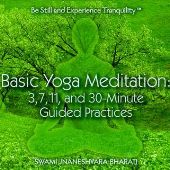Home Site Map CDs Karma sources Behind canvas Domains Consciousness
Archery
and the Art of
Reducing Karma through Yoga
by Swami
Jnaneshvara Bharati
Homepage
The
law of karma, |
Reducing karma through archery: The ancient sages of Yoga and Vedanta use the metaphor of Archery as a teaching tool for how to work with and reduce karma through the process of Yoga meditation. In Yoga Meditation, Karma is of three kinds: Sanchita, Kriyamana, and Prarabhda, using the metaphor of three kinds of arrows in archery. Karma Yoga is the Yoga that emphasizes doing Yoga while also doing actions in the world, or Meditation in action.
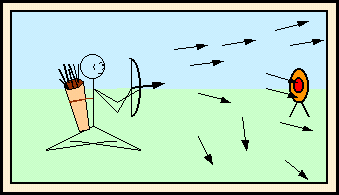
Index
of this web page:
Three
Kinds of Arrows & Karma
Arrows in the Quiver (Sanchita karma)
Arrows
in Flight (Prarabhda karma)
Arrows in Hand (Kriyamana karma)
Improving
Your Aim
Letting the Stray Arrows Fall
Reducing the Arrows in the Quiver
Being
a Peaceful Archer
Meditation in Archery
See
also:
Karma and the Sources of Actions, Speech and Thoughts
Three Kinds of Arrows & Karma
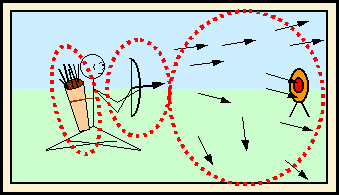
Arrows and Karmas:
There are three kinds of Karma (further described below):
- Sanchita, the vast storehouse of yet unseen impressions
- Kriyamana, those currently in front of us to decide or act on
- Prarabhda, consequences already playing themselves out
Similarly, there are three kinds of arrows:
- Quiver: Arrows in the Quiver (Sanchita karma)
- Hand: Arrows in Hand (Kriyamana karma)
- Flight: Arrows in Flight (Prarabhda karma)
This is a very practical tool: The metaphor of the arrows is a practical tool for daily life. The mind easily recalls the visual imagery, which serves as a reminder to do a good job of "shooting the arrows" of actions and speech.
- Decisions: The quality of our decisions leads to the quality of our actions, which means the level of our archery ability.
- Consequences: The aim of the arrows also determines the quality of the consequences that come back from those actions.
- Deep impressions: Those consequences come to rest in the bed of our subconscious as deep impressions (Samskaras) which determine our Karma.
- Recycling: These Samskaras will at some point lead to further thoughts, speech, and actions, that again lead to more consequences.
Learn to have a good aim: Remembering to act as a skilled Archer is very useful for making decisions that will later have positive consequences on our mental, emotional, and spiritual lives. The key is becoming "a good shot" with the arrows in our hand, while accepting that some of our previously shot arrows are causing painful, unavoidable consequences that need to be dealt with wisely.
Karma means actions: "Karma" literally translates as "Actions," and is the playing out of the actions resulting from the latent habit patterns, or Samskaras, that are stored in the depth of the mind.
Stages of karma: There are three stages through which karma flows:
- Impressions from past consequences: First, there are the deep impressions which come as a result of the storing of consequences from previous actions, and the natural feedback from the senses receiving input. (arrows in the quiver)
- These impressions come forward: Second, these deep impressions come to the forefront of one's life at some point in time in the future, whether or not it comes with conscious awareness. (arrows in hand)
- Actions and speech spring forth: Third, there are then actions and speech that spring forth, with or without the wisdom of conscious choice. (arrows in flight)
See also:
Karma and the Sources of Actions, Speech and Thoughts
Arrows in the Quiver (Sanchita karma)
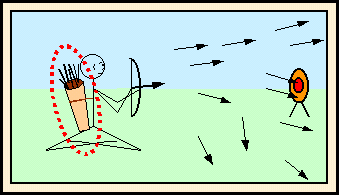
Accumulated impressions: The karmas in the quiver are the accumulated deep impressions (Samskaras) that have been collected over our entire history. Some arrows have been added to the quiver (new Karmas) and others have already been shot (old Karmas), and are no longer in the quiver.
The formula of karma: The total of the arrows (Samskaras) in our quiver today is the net of the new arrows added, minus the old ones that have been shot. These arrows and deep driving habits in the quiver are called "Sanchita Karma."
|
Current karma
= |
It takes time: Because of the process of playing out old Samskaras while new, more useful ones are added, it takes time for one's balance of karma to improve. In other words, it doesn't happen overnight (recognizing that God, grace, or guru might help).
Predispositions are awaiting opportunity: Along with the playing out of our current Karmas in flight, we also know that there are many predispositions, habit patterns, or Samskaras that there awaiting an opportunity to come into action. Though we may not know exactly what these are, by observing our actions we can infer some of these predispositions.
Examining and attenuating karma: By a good job of preparation, balancing life, and learning to be a good Archer, one can eventually examine the Samskaras in the quiver during Yoga Meditation and Yoga Nidra (Yogic sleep). In this way, deeper habit patterns can be attenuated or eliminated through Meditation, provided one has become trained as a good Archer.
Colored and uncolored impressions: Yoga science speaks of colored (klishta) and uncolored (aklishta) thought patterns. When these deeply colored thought patterns are regulated, and their coloring has been reduced through good archery skills, then one may move on to experience Self-Realization.
Arrows in Flight (Prarabhda karma)

Arrow already shot: The arrows in flight are the Karmas that have already started to play themselves out, either in our inner world or in the external world. These are the arrows that have already been shot. The arrows and our actions still in flight are called "Prarabhda Karma."
They have to run their course: An arrow in flight cannot be called back. It must complete its journey. Thoughts, speech, and actions that have been set in motion cannot be called back. They too will run their course, bringing consequences or fruits. (Some say that this Karma can be altered by grace.)
New decisions can help: New decisions can be made that balance out the effects of previously shot arrows. This is a good thing to do, as it improves the overall mixture of arrows in flight. However, the original arrows still move towards their fruition.
Learning to accept our consequences: The lesson for the seeker of Self-Realization is to accept that there are physical, mental, emotional, social, cultural, familial, financial, or material consequences of all of our previous actions (shot arrows). These simply need to be accepted as realities from which we now move forward in our spiritual quest.
The here and now: The arrows in flight need to be dealt with from the stance of the here-and-now, in the context of how we shoot today's arrows.
Arrows in Hand (Kriyamana karma)
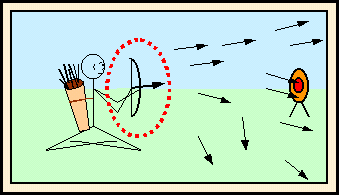
The arrows in hand are the most important: The arrows that are in our hands today are the ones that we currently have a choice about where to aim and how to shoot. The arrows and choices in our hands today are called "Kriyamana Karma" (also called "Agami Karma" or "Vartamana Karma").
Becoming more aware: To be aware of the nature of wants, wishes, desires, attractions or aversions is very important. By being aware of our motivations, we can consciously shoot the arrows by choice, rather than unconscious habit.
Making good decisions: Through cultivating awareness and practicing conscious arrow shooting, we become better at aiming our arrows as well. We make good decisions about our thoughts, emotions, actions, and speech, rather than having these happen solely out of conditioned response.
Formula for archery: So, the formula, starting with Awareness, is:
- Awareness of motivations: Awareness of motivations allows us to learn to shoot arrows out of choice, rather than habit.
- Conscious arrow shooting: Through conscious arrow shooting, the aim gets better with practice.
- Outcomes improve: As the aim gets better, the outcomes are more favorable.
- Net karma goes down: If the outcomes are more favorable, net Karma goes down.
Primitive urges are the background
motivation: Behind our actions are many thoughts, emotions,
desires, samskaras, and primitive urges. By being aware of the process
leading to actions, we can make wise choices about
those actions.
(See "Karma and the Sources of Actions, Speech,
and Thoughts")
Arrows in daily life: One may have either a few arrows, or many arrows in the quiver (little Karma or a lot of Karma), but what is important is how we deal with the Karma presenting to us in our lives today. This is the art of Archery and reducing Karma. The law of Karma is universal; as you sow, so shall you reap. The words and cultural contexts may differ, but the principle remains the same. Learning to be a Master Archer is the key to mastery over the bondage of Karma.
Deciding what is the target: Where to aim our arrows is a critically important question. If we don't know what the target is, then it is rather difficult to aim well. Our arrows are shot almost at random, at every want, wish, desire, attraction, or aversion that pops up into the mind.
Understanding the purpose of life: Deciding what is the target means to understand the purpose of life. If the Archer has a sense of the purpose of life, using whatever words best describe that personally, then there is a target that all of the arrows can be directed towards. It means that one's decisions are increasingly made in accordance with what brings one closer to the chosen target.
What actions will serve Self-realization?: For one who chooses Self-Realization as the target, then decisions are made on the basis of what brings one closer, or leads one further away from that Goal.
Improving Your Aim
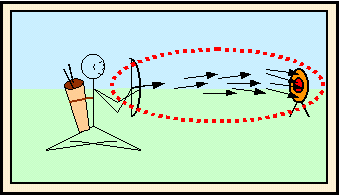
Is it useful or not useful?: This is the most important aspect of the Archery metaphor. It means asking our deep Wisdom, "Is this useful or not useful?" about specific options in front of us. "Does this bring me closer or further away from the goal of Enlightenment?" "Should I do it, or not?" By consulting within in this way, answers will come.
Consulting Buddhi: In the Four Functions of Mind, the part that knows, decides, judges, and discriminates is called Buddhi. It is through the cultivation of Buddhi that one becomes a better Archer, training Manas (the lower mind) to follow the wise instructions of Buddhi, rather than just following the old habit patterns in Chitta (the storehouse of Samskaras, or deep impressions and habits).
Determining actions by choice: It is a matter of actions being determined by the choice of Buddhi rather than by the unconscious impressions arising from the quiver. It works something like this:
- Once the target, or purpose is known,
- When Buddhi can make choices,
- And when Manas will listen,
- Then the arrows of action are shot in more accurate ways,
- And there are fewer negative consequences,
- As well as a greater number of useful consequences.
- These useful impressions are stored in the quiver.
- In turn, these arise to motivate further useful actions,
- And we experience an overall reduction in our Karma.
The aim improves by consulting Buddhi: Through this repeated cycle of utilizing Buddhi to determine the aim of the arrows of action, one becomes a better and better Archer. As we become a better Archer, the process of reducing Karma works better and better.
What to do with the fruits of actions: An important key to shooting our arrows well has to do with the question of who is to receive the fruits of the actions. There are three general choices of where to give the fruits of actions:
- The fruits come to me.
- The fruits are given to others.
- The fruits are offered to God.
The question of what to do with the fruits of actions is an important part of Karma Yoga, the Yoga of Action, which prepares one to do the deeper practices leading to Self-Realization.
Selfless service: Consequences of actions breed more actions, and in turn, more consequences. This cycle happens because of one's attachment or aversions to the fruits of the actions. However, the more one practices selfless service, giving away the fruits of the actions to others, then the less those fruits turn into negative consequences that feed the cycle.
For example, if one is attached to the financial fruits of his or her job, then those financial fruits might be used to seek pleasure in the external world. When those external pleasures end up being inadequate, one might end up seeking even more fruits in an attempt to feel satisfied.
Other fruits might be, for example, the accolades, recognition, or the internal feelings of accomplishment coming from actions. These too can leave one in a painful cycle of seeking greater and greater fruits in an effort to feel whole and fulfilled.
A shift in attitude about fruits: However, if the same person has a shift in attitude, whereby the fruits of their labors are for others, such as family, friends, customers, clients, society, or humanity then one is free of the fruits. In other words, one learns to give away the fruits of the actions. Then the inner motive is to serve those other people, not merely to feed one's own sense of personal needs.
The paycheck, accolades or recognition will still come and be enjoyed, but it is without expectation that these fruits themselves are capable of bringing happiness. When the fruits are given up, then one is free. The feelings of wholeness and fulfillment can then come from within, regardless of the outcomes of the actions.
Refinement leads to freedom: It is an ongoing feedback loop of shooting arrow, refining one's aim, and shooting again that leads to being a good Archer, and to freedom from the bondage of Karma.
Letting the Stray Arrows Fall
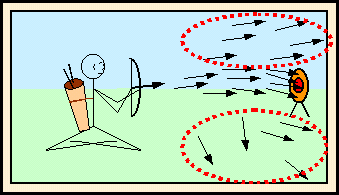
Reducing the In-flight arrows: When we start improving our aim, and thus creating fewer attachments and aversions, we also have to deal with the arrows that are already in flight. Some of these in-flight arrows are painful, some are pleasurable. Whether bringing pain or pleasure, the consequences of these previously-shot arrows continues to come, until those arrows find their final destination and completion.
A simple process: There is a simple process to reducing the in-flight arrows:
We allow the arrows to fall where they are headed, accepting that some of them were poorly aimed. Past decisions are bringing current consequences. We accept these consequences and their responsibilities, as we stay focused on the arrows in hand. We allow the old arrows to run their course in such a way that we don't add more negative consequences to come.
Not becoming diverted by the in-flight arrows: Because of these stray arrows, one may easily become diverted from the path of Self-realization. Those old arrows, shot long ago, continue to come and cause problems. Often what happens is that due to these old arrows, still in flight, we end up firing more arrows along the same off-course path. We can end up having just as many arrows in the air that are off-course, rather than seeing the number go down.
Being kind to ourselves: The solution is to be very kind with ourselves, as we cultivate persistence and patience. We may want spiritual energy, grace, or shakti to come to us, yet one of the first forms of that comes as determination. To have, cultivate, or pray for such determination is an essential practice on the journey to Self-Realization.
- Becoming a good Archer in making useful decisions, developing determination, and practicing patience, form a powerful combination.
- Then, the number and intensity of off-course arrows of Karma gradually goes down, as the number that are on-target increases.
- Gradually our karmic focus shifts, as we move more and more towards a greater integration of mind, and reduction of samskaras
- Then our meditations and contemplations can progress more smoothly and quickly on the Journey Within.
Reducing the Arrows in the Quiver (Sanchita karma)
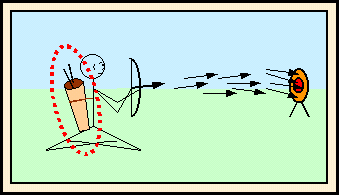
The past impressions: The entire collection of the deep impressions (samskaras) that forms our past karma is the Prarabhda karma. Mostly, it sits in latent form until such time as some of it is ready to come to life, first in the mind-field, and then in the external world through actions and speech.
They start a cycling process: As these impressions turn into action, their consequences often come back through the senses, get processed by the mind and make still more impressions in the deep unconscious. The cycle of impression-action-consequence-impression goes on and on.
Be more mindful of choices and actions: However, by being more mindful of the nature of our choices and actions, we can allow our karmas to play themselves out, while not replacing them with new binding consequences being added to the quiver. Then we can have a reduction in the total Karmas stored in those Samskaras.
Examining and attenuating the latent arrows: The combination of having fewer arrows in the quiver and fewer negative arrows in flight leads the aspirant to do an even better job of examining and attenuating those remaining Samskaras during Yoga Meditation.
It can seem to be getting worse: Paradoxically, the Karmic arrows in the quiver might come to the surface in big clusters. It can seem that problems in life are getting worse! The life, consequences and actions coming forth might appear to be very unspiritual. This is the reason that there are stories of saints doing outrageous behaviors, as some of the few remaining Karmas manifest.
Self-Realization does not require removing all the arrows: The experience of the Self does not depend on having 100% of the Samskaras removed, such that there is no more Karma. Self-Realization does not stop the flow of the Karmas playing out, nor necessarily remove the latent Karmas in the storehouse. Though some of the seeds of karma may become so weakened or "burned" in the fire of Consciousness that they can no longer bear fruit, others remain.
The potter's wheel continues to turn: The sages use the metaphor of the potter's wheel. After the pot is made, the potter's wheel continues to turn because of its previous impetus. So too, the Karmic impressions in the quiver continue to drive thoughts, actions, and speech. However, the aspirant becomes better and better at directing those forces when they arise. Even Patanjali (codifier of the Yoga Sutra) gives instructions of how to handle breaks in enlightenment by continuing to purify the latent impressions.
Efficiently working with karma: At this phase of Archery training, one has become a Master Archer, and does an efficient job of working through the remaining Karmas while remaining in the world, but above the world.
Being a Peaceful Archer
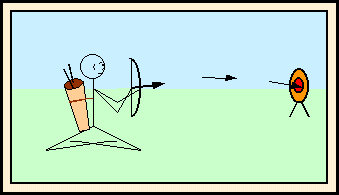
Archery in Yoga Meditation: Having a good aim in decisions and actions of daily life reduces Karma by having "the new" come into play, as "the old" works itself out. The same process is also done during Yoga Meditation.
Meditation in Action: In the external world, the Yogi allows the old Karmas (the arrows in flight) to play themselves out. In the internal world, the Yogi also allows the old Karmas to play themselves out, as the inner drama is observed from the vantage point of a Witness. For this reason, both "Meditation" and "Meditation in Action" are a part of Archery and the Art of Reducing Karma.
Seated meditation: In seated Meditation one allows the thought patterns come forward, learns to be undisturbed, unaffected, and uninvolved in them. They come, and they go. In this way, the intensity of the coloring of the deep impressions gradually attenuates. This is a process whereby the colored Samskaras (klishta) gradually have their coloring dissipated, as the thought patterns move towards being completely uncolored (aklishta).
Meditation and Meditation in Action: When the Samskaras weaken through Yoga Meditation, they can be more easily played out in daily life. When the Samskaras weaken through the actions of daily life, then they can more easily be played out in Meditation. The two practices of Meditation and Meditation in Action go hand in hand.
Meditation in Archery
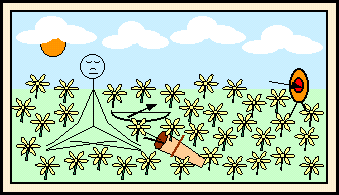
Good Archery removes the veil over the Self: Being a good Archer does not in itself bring Self-Realization. Rather, it is a means of reducing and removing obstacles. Learning the art of Archery reduces Karma so that one can rest in the stillness and silence.
Then, through the practices of Meditation, Contemplation, Prayer, and remembering Word or Mantra, the Self that has been there all along can be Realized.
------- This site is devoted to
presenting the ancient Self-Realization path of
the Tradition of the Himalayan masters
in simple, understandable and beneficial ways, while not compromising
quality or depth. The goal of our sadhana or practices is the highest
Joy that comes from the Realization in direct experience of the
center of consciousness, the Self, the Atman or Purusha, which is
one and the same with the Absolute Reality.
This Self-Realization comes through Yoga meditation of the Yoga
Sutras, the contemplative insight of Advaita Vedanta, and the
intense devotion of Samaya Sri Vidya Tantra, the three of which
complement one another like fingers on a hand.
We employ the classical approaches of Raja, Jnana, Karma, and Bhakti
Yoga, as well as Hatha, Kriya, Kundalini, Laya, Mantra, Nada, Siddha,
and Tantra Yoga. Meditation, contemplation, mantra and prayer
finally converge into a unified force directed towards the final
stage, piercing the pearl of wisdom called bindu, leading to the
Absolute.

